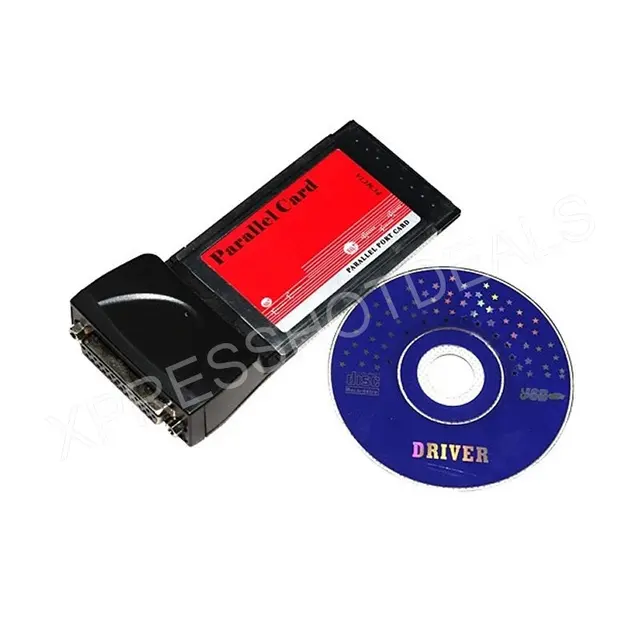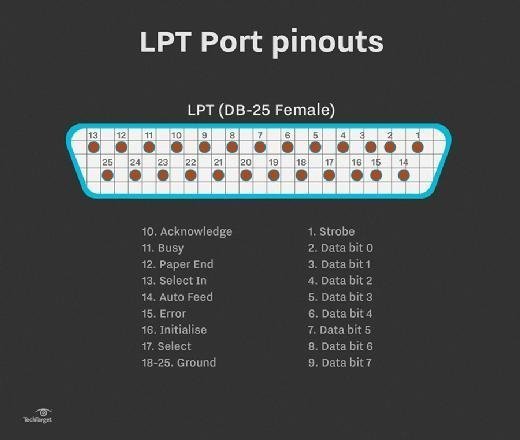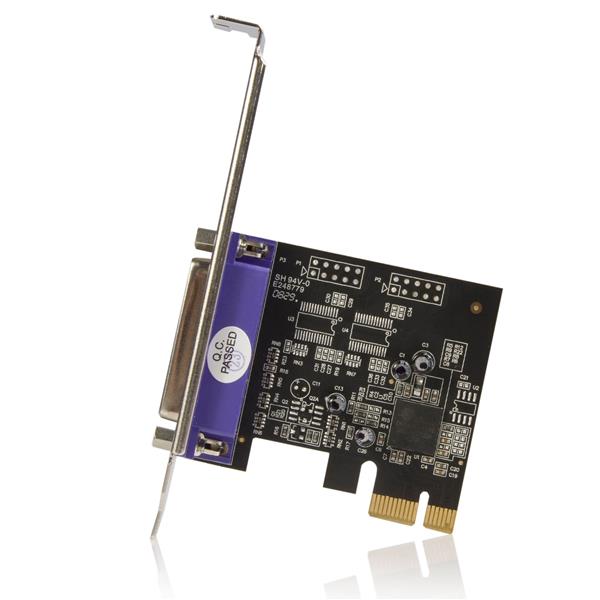Ecp Parallel Port Driver For Mac
VMware Workstation 3.2 Using Parallel Ports Using Parallel Ports The following sections describe how to use parallel ports with VMware Workstation:. VMware Workstation supports two types of virtual parallel port devices: unidirectional ports (SPP) and a partial emulation of bidirectional PS/2-style ports. Bidirectional ports are supported on all Windows hosts. Unidirectional ports are supported in all Linux versions. Bidirectional ports are supported in Linux kernel versions 2.2.5 or later.
- Ecp Parallel Port Driver For Mac Pro
- Ecp Parallel Port Driver For Mach3
- Ecp Parallel Port Driver For Mac Free
On Linux hosts, VMware Workstation requires that the parallel port 'PC-style hardware' option (CONFIGPARPORTPC) be built and loaded as a kernel module (that is, it must be set to 'm'). VMware Workstation is unable to use bidirectional parallel port devices if CONFIGPARPORTPC is built directly (compiled) into the kernel.
This limitation exists because CONFIGPARPORTPC does not correctly export its symbols. Unidirectional Ports Unidirectional Ports Unidirectional ports are supported for backward compatibility. They are used typically to connect to printers or to send the printer output to a file. The speed is usually adequate for printing text, but expect long delays when printing images. On a Linux host, the path names of the host devices for unidirectional ports are typically /dev/lp0, /dev/lp1, etc. Bidirectional Ports Bidirectional Ports Bidirectional ports are used by a variety of devices - printers, scanners, dongles and disk drives, for example.
Currently, VMware Workstation provides only partial emulation of PS/2 hardware. Specifically, interrupts requested by a device connected to the physical port are not passed to the virtual machine. Also, the guest operating system cannot use DMA (direct memory access) to move data to or from the port.
For this reason, not all devices that attach to the parallel port are guaranteed to work correctly. Below is a partial list of devices known to work. If you try out a device that is not on the list, please let VMware know. Bidirectional emulation is slower than native access but faster than unidirectional emulation, so bidirectional mode is recommended, when possible, even when the device connected to the port is unidirectional (a printer, for example). Default Configuration Default Configuration When parallel ports are set up on a Windows host, they are bidirectional by default. Their default base addresses are, in order, 0x3bc, 0x378 and 0x278. None of the ports have an assigned IRQ or DMA channel.
Ecp Parallel Port Driver For Mac Pro
The ports are not present by default. When parallel ports are set up on a Linux host, they are bidirectional by default on Linux hosts with kernel 2.2 or higher. Otherwise, they are unidirectional. Their default base addresses are in order, 0x3bc, 0x378 and 0x278. None of the ports have an assigned IRQ or DMA channel. The ports are not present by default. Installation in Guest Operating Systems Installation in Guest Operating Systems If the virtual machine is configured with a parallel port, most guest operating systems automatically detect it at installation time and install the required drivers.
Some operating systems, including Linux, Windows NT and Windows 2000, automatically detect the port(s) at boot time. Others, like Windows 9x, do not.

To add a parallel port to the virtual machine's configuration, take these steps with the virtual machine powered off. Windows Hosts Windows Hosts. Open the Configuration Editor. Settings Configuration Editor. Click Add to start the New Hardware Wizard. Select Parallel Port, then click Next.
Make the appropriate selection to use a physical parallel port or connect the virtual parallel port to a file. If you want the parallel port output to go to a file, enter the path and filename or browse to the location of the file.
Click Finish. Linux Hosts Linux Hosts. Open the Configuration Editor.
Settings Configuration Editor. Click the + sign beside Parallel Ports to expand the list of devices. Select a device that is shown as Not Installed. From the Type drop-down list, select Device to connect to a physical parallel port on the host or File to send the output to a file. In the Path field, enter the path to the device or file you want to use. The path names of the host devices for bidirectional parallel ports are usually /dev/parport0, /dev/portport16, /dev/parport32, etc.

The VMware Workstation installer creates these devices if they do not exist. They may also be created by hand using mknod. For example, to create the second parallel port ( parport16) use this command: mknod /dev/parport16 c 99 16.

Click Install to install the virtual parallel port, then click OK to save the configuration and close the Configuration Editor. In a Windows 9x guest, when you change a port from unidirectional to bidirectional or vice versa, you must use the Device Manager ( Start Settings Control Panel System Device Manager) to remove the device driver for that port and add a new one.
Adding a new driver is also required when a new port is added. In both cases use the guest operating system's Add New Hardware Wizard ( Start Settings Control Panel Add New Hardware) and let Windows detect the new device. Manually selecting the device from a list may result in an incorrect configuration. Troubleshooting Troubleshooting If an error message appears at power on stating the parallel port on the host does not have an ECR (extended control register), it is possible the hardware supports it but it has been disabled in the BIOS.
In this case, reboot your host computer, enter the BIOS configuration editor (typically by holding down the Delete key during early execution of the BIOS), find the parallel port field, and enable ECP mode (or other combination of modes that include ECP). Most modern computers should support ECP mode. Configuring a Bidirectional Parallel Port on a Linux Host Configuring a Bidirectional Parallel Port on a Linux Host For the bidirectional parallel port to work properly in a guest, it must first be configured properly on the host.
Most issues involving parallel port functionality are a result of the host configuration. Check these areas of concern: the version of your Linux kernel, your device access permissions and required modules. Bidirectional Parallel Ports and Linux 2.2.x Kernels Bidirectional Parallel Ports and Linux 2.2.x Kernels The 2.2.x kernels that support bidirectional parallel ports use the parport, parportpc and vmppuser modules. Also, be sure that PC Style Hardware (CONFIGPARPORTPC) is loaded as a module, as mentioned at the beginning of this section on using parallel ports.
The vmppuser module is supplied by VMware Workstation to give virtual machines user-level access to the parallel port. To see if these modules are installed and running on your system, run the lsmod command as the root user. These three modules should be included in the listing of running modules.
You can also look at the /proc/modules file for the same list. To load the proper modules, run this command: insmod -k If none of the listed parallel port modules is running, use this command: insmod -k parportpc This inserts the three modules needed for a bidirectional parallel port.
If you continue to see problems, it is possible that the lp module is running. If it is, the virtual machine cannot use the parallel port correctly. To remove the lp module, run this command as the root user: rmmod lp The lp module is necessary only for unidirectional parallel ports.
You should also ensure that the line referring to the lp module in the /etc/modules.conf or /etc/conf.modules file is removed or commented out by inserting a # at the beginning of the line. The name of the configuration file depends on the Linux distribution you are using. When you reboot the host after removing this line, the configuration file no longer starts the lp module. To ensure that the proper modules for the bidirectional parallel port are loaded at boot time, add this line to the /etc/modules.conf or /etc/conf.modules file: alias parportlowlevel parportpc Bidirectional Parallel Ports and Linux 2.4.x Kernels Bidirectional Parallel Ports and Linux 2.4.x Kernels Be sure that PC Style Hardware (CONFIGPARPORTPC) is loaded as a module as mentioned at the beginning of this section on using parallel ports.
Ecp Parallel Port Driver For Mach3
If you are using a 2.4.x kernel, the modules that provide bidirectional parallel port functionality are parport, parportpc and ppdev. To see if these modules are installed and running on your system, run the lsmod command as the root user. These three modules should be included in the listing of running modules. You can also look at the /proc/modules file for the same list. To load the proper modules, run this command: insmod -k If none of the listed parallel port modules is running, use this command: insmod -k parportpc This inserts the three modules needed for a bidirectional parallel port. If you continue to see problems, it is possible that the lp module is running.
Ecp Parallel Port Driver For Mac Free
If it is, the virtual machine cannot use the parallel port correctly. To remove the lp module, run this command as the root user: rmmod lp The lp module is necessary only for unidirectional parallel ports. You should also ensure that the line referring to the lp module in the /etc/modules.conf or /etc/conf.modules file is removed or commented out by inserting a # at the beginning of the line. The name of the configuration file depends on the Linux distribution you are using. When you reboot the host after removing this line, the configuration file no longer starts the lp module. To ensure that the proper modules for the bidirectional parallel port are loaded at boot time, add this line to the /etc/modules.conf or /etc/conf.modules file: alias parportlowlevel parportpc Linux kernels in the 2.4.x series also use a special arbitrator that allows access to the parallel port hardware. If the parallel port is in use by the host, the guest cannot use it.
If a virtual machine is using the parallel port, the host and any users accessing the host are not given access to the device. VMware Workstation puts a lock on the device, and this lock restricts access so only the virtual machine can use the port. You can use the Devices menu to disconnect the parallel port from the virtual machine and reconnect it. Device Permissions Device Permissions Some Linux distributions by default do not grant the virtual machine access to the lp and parport devices. In most of these cases, the owner of the device is root and the associated group is lp. To allow the VMware user to access the device, add the user to the associated group. To view the owner and group of the device, run this command: ls -la /dev/parport0 The third and fourth columns of the output show the owner and group, respectively.
To add the user to the device group, edit the /etc/group file. On the line starting with lp, which defines the lp group, add the VMware Workstation user's user name. You must make this change as the root user. The following line provides an example for a user whose user name is userj. Lp::7:daemon,lp,userj The next time the user logs on to the host, the changes take effect. Devices You Can Use on a Bidirectional Parallel Port Devices You Can Use on a Bidirectional Parallel Port Devices Known to Work Adobe dongle Windows 95 guest RIO MP3 player Windows 95 guest UMAX Astra 1220 P scanner Windows 95 guest Hewlett-Packard LaserJet 5MP printer Windows 9x and Windows NT/2000 guests Canon Bubble Jet BJ-200e printer Windows 9x and Windows NT/2000 guests Iomega ZIP drive Linux, Windows NT, and Windows 2000 guest only (see Special Notes for the Iomega Zip Drive, below) Devices Known to Work. Linux, Windows NT, and Windows 2000 guest only (see Special Notes for the Iomega Zip Drive, below) Devices That Probably Work Dongles Most dongles are likely to work.
Printers Most printers are likely to work. Hewlett-Packard Deskjet 710C Reported by customer. Hewlett-Packard Deskjet 722C Reported by customer. Epson 750 printer in bidirectional mode Reported by customer. CARDport Swift Smart Media Digital Image Reader/Writer from Chase Advanced Technologies Reported by customer.
Logitech Scanman Color 2000 (parallel port hand scanner) Reported by customer. Plustek Optic Pro 9636T Flatbed Scanner Reported by customer.
Creative Labs WebCam II (parport version) Reported by customer. Devices That Probably Work.